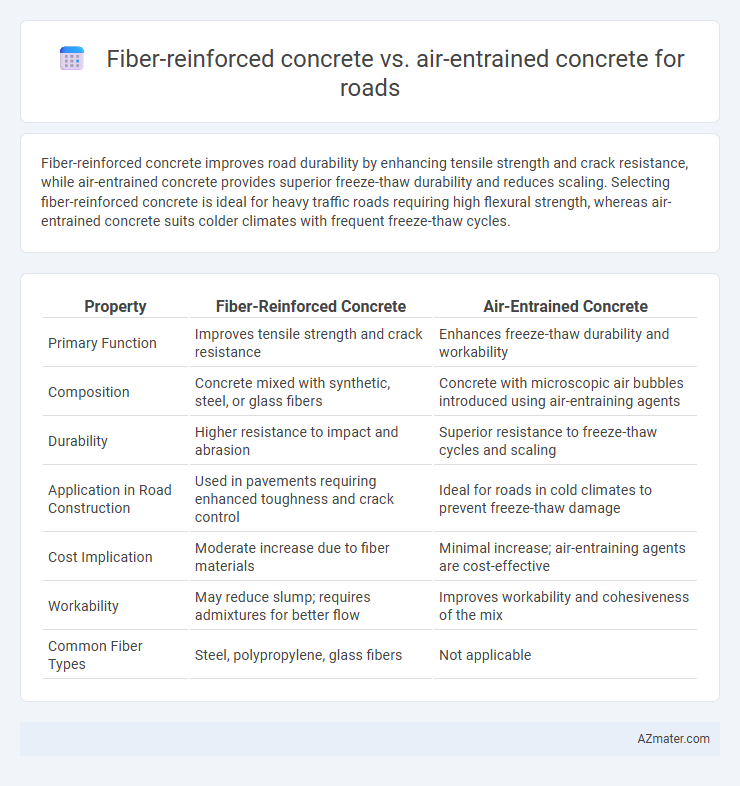Fiber-reinforced concrete improves road durability by enhancing tensile strength and crack resistance, while air-entrained concrete provides superior freeze-thaw durability and reduces scaling. Selecting fiber-reinforced concrete is ideal for heavy traffic roads requiring high flexural strength, whereas air-entrained concrete suits colder climates with frequent freeze-thaw cycles.
Table of Comparison
| Property | Fiber-Reinforced Concrete | Air-Entrained Concrete |
|---|---|---|
| Primary Function | Improves tensile strength and crack resistance | Enhances freeze-thaw durability and workability |
| Composition | Concrete mixed with synthetic, steel, or glass fibers | Concrete with microscopic air bubbles introduced using air-entraining agents |
| Durability | Higher resistance to impact and abrasion | Superior resistance to freeze-thaw cycles and scaling |
| Application in Road Construction | Used in pavements requiring enhanced toughness and crack control | Ideal for roads in cold climates to prevent freeze-thaw damage |
| Cost Implication | Moderate increase due to fiber materials | Minimal increase; air-entraining agents are cost-effective |
| Workability | May reduce slump; requires admixtures for better flow | Improves workability and cohesiveness of the mix |
| Common Fiber Types | Steel, polypropylene, glass fibers | Not applicable |
Introduction to Advanced Road Concrete Technologies
Fiber-reinforced concrete enhances road durability by integrating synthetic or steel fibers that improve tensile strength, crack resistance, and impact absorption, making it ideal for high-traffic highways and heavy-load pavements. Air-entrained concrete incorporates microscopic air bubbles to increase freeze-thaw resistance, reducing surface scaling and improving longevity in cold climates. Advances in road concrete technologies combine these methods to optimize performance, reduce maintenance costs, and extend pavement service life under varying environmental conditions.
Understanding Fiber-Reinforced Concrete
Fiber-reinforced concrete (FRC) enhances road durability by incorporating synthetic or steel fibers that improve tensile strength, crack resistance, and impact absorption compared to traditional air-entrained concrete. Unlike air-entrained concrete, which mainly improves freeze-thaw resistance through microscopic air bubbles, FRC provides superior load-bearing capacity and reduces the likelihood of surface deterioration and potholes under heavy traffic. Fiber types, dosage, and distribution significantly influence FRC's performance in road construction, making it ideal for high-stress environments requiring enhanced structural resilience.
Overview of Air-Entrained Concrete
Air-entrained concrete contains microscopic air bubbles that improve freeze-thaw durability and reduce damage from water expansion, making it ideal for road surfaces exposed to harsh weather. This type of concrete enhances resistance to scaling and improves overall longevity in pavements subjected to frequent freeze cycles. Its air-void system also helps to maintain workability and reduces the risk of cracking under thermal stress.
Key Material Properties Comparison
Fiber-reinforced concrete enhances tensile strength and crack resistance through the integration of synthetic or steel fibers, improving durability under traffic-induced stress. Air-entrained concrete contains microscopic air bubbles that increase freeze-thaw resistance and reduce scaling, making it ideal for cold climates. While fiber-reinforced concrete excels in flexural toughness and load-bearing capacity, air-entrained concrete prioritizes freeze-thaw durability and resistance to deicing chemicals in road applications.
Durability in Extreme Weather Conditions
Fiber-reinforced concrete significantly enhances durability in extreme weather conditions by improving crack resistance and impact strength, reducing the likelihood of surface deterioration under freeze-thaw cycles and thermal expansion. Air-entrained concrete, designed with microscopic air bubbles, provides superior freeze-thaw resistance by accommodating water expansion during freezing, which prevents internal pressure buildup and surface scaling. For road applications exposed to harsh climates, combining fiber reinforcement with air-entrainment optimizes durability by addressing both mechanical stresses and freeze-thaw damage effectively.
Structural Performance and Load-Bearing Capacity
Fiber-reinforced concrete enhances structural performance by improving tensile strength, crack resistance, and durability, making it ideal for high-load bearing roads subjected to heavy traffic. Air-entrained concrete primarily increases freeze-thaw durability but offers lower tensile strength and load-bearing capacity compared to fiber-reinforced variants. For roads requiring superior load-bearing capacity and structural integrity, fiber-reinforced concrete provides significant advantages in withstanding dynamic loads and impact stresses.
Resistance to Cracking and Surface Damage
Fiber-reinforced concrete significantly improves resistance to cracking and surface damage in road applications by distributing stresses and enhancing tensile strength through embedded fibers such as steel, polypropylene, or glass. Air-entrained concrete primarily enhances freeze-thaw durability by creating microscopic air bubbles that relieve internal pressure, but it does not provide the same level of crack resistance or mechanical toughness as fiber reinforcement. Therefore, fiber-reinforced concrete offers superior performance in controlling cracking and surface deterioration under heavy traffic and environmental stresses.
Cost Analysis and Long-Term Maintenance
Fiber-reinforced concrete typically incurs higher initial costs than air-entrained concrete due to the expense of synthetic or steel fibers, but it enhances durability by reducing crack propagation and improving tensile strength, which lowers long-term repair expenses. Air-entrained concrete, while less costly upfront, provides better freeze-thaw resistance, minimizing surface scaling and pothole formation in colder climates, thus reducing maintenance frequency and associated costs over time. Evaluating lifecycle costs, fiber-reinforced concrete's superior structural performance can lead to fewer maintenance interventions, whereas air-entrained concrete offers cost-effective protection against weather-induced deterioration in road surfaces.
Best Use Cases for Each Concrete Type in Road Construction
Fiber-reinforced concrete excels in road construction requiring enhanced tensile strength, crack resistance, and durability under heavy traffic loads, making it ideal for highways, airport runways, and industrial pavements. Air-entrained concrete is best suited for roads exposed to freeze-thaw cycles, as its microscopic air bubbles improve resistance to frost damage and improve durability in cold climates. Selecting between fiber-reinforced and air-entrained concrete depends on traffic demands and environmental conditions, optimizing longevity and performance in road infrastructure.
Conclusion: Selecting the Optimal Concrete for Modern Roads
Fiber-reinforced concrete enhances tensile strength and crack resistance, making it ideal for roads subject to heavy loads and dynamic stresses. Air-entrained concrete improves freeze-thaw durability by introducing microscopic air bubbles, essential for colder climates with frequent temperature fluctuations. For modern road construction, integrating fiber reinforcement with appropriate air entrainment offers the most durable and resilient pavement solution.

Infographic: Fiber-reinforced concrete vs Air-entrained concrete for Road
 azmater.com
azmater.com